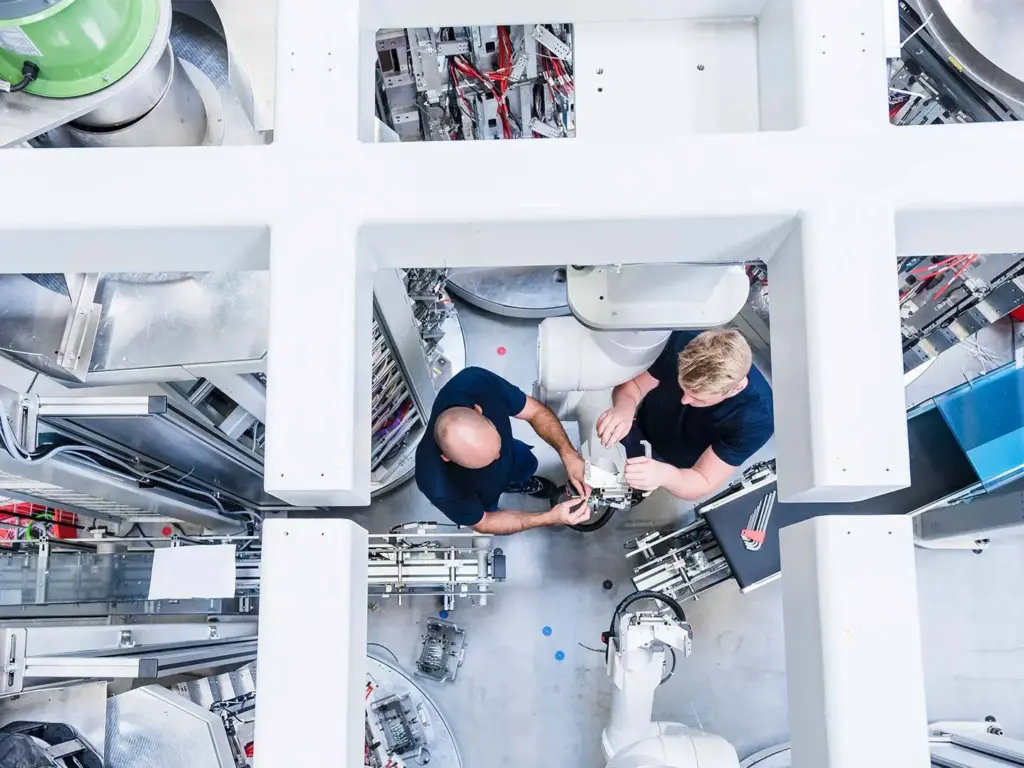Economists often look forward to make predictions about where markets are headed. This exercise is part data science, part experiential wisdom, and part wishful thinking. Recently, talk of “the r-word” has bubbled up among economists and internal teams as we face uncertainty and disruption at the local, national, and global level. This consciousness of recession potential has had direct and indirect effects on how forward-thinking businesses operate and prioritize, especially when it comes to digital transformation initiatives.
I wanted to explore this issue with someone who has a regular pulse on the depth and breadth of strategic thinking both within Vervint and among Vervint’s clients: Todd Jacobs. Todd worked as a delivery lead for several years here at Vervint before he transitioned into the role of principal consultant in early 2019. As a principal, Todd wears a lot of hats. From tactical on-the-ground leadership to relationship building to high-level strategy, Todd and the other principals at Vervint facilitate, enable, support, and lead across teams while also staying connected with clients.
Among his other duties, Todd has worked to develop and clarify Vervint’s position around recession business strategies, which is why I wanted to get a discussion going with him about what he has been seeing lately, what practical insight he has for businesses facing slowed market growth, and other recession-related topics.
Update: May 2020
So, I know we’ve seen a resurgence in talks about recession in recent weeks; do you have any thoughts or ideas you wanted to share?
I went back and re-read our interview, and the advice and insights we shared hold up. At the time we first spoke, the market was heading toward gains and stability, and now there has been a sudden influx of uncertainty. Some of this was predictable. For example, we talked about the election being a potential factor in the economy to some degree. But a lot of it feels like it came way out of left field, like the global COVID-19 pandemic. Given the fluctuations in the stock market lately, it’s more important than ever for companies and individuals to take the advice of most financial analysts: remain conscientious around your investment strategies, especially from a long-term perspective.
Over the past few weeks, we have seen tremendous market swings of thousands of points per day. This volatility has reignited an uncertain feeling about the outlook of the market, especially sentiments about a correction or downturn. But, resilience is (and remains) the undertone as businesses look to carry their digital business model forward. Think about when Apple introduced the first iPhone; that was mid-2007!
The approach to enterprise technology investments when faced with uncertainty doesn’t really change: align your digital initiatives with your long-term business goals, make sure you can measure your ROI, and then be smart about where you’re allocating funds toward digital transformation. Invest when the time is right. But even when the time feels wrong, that can be an even better time to do it.
Right now, businesses are, responsibly, working to keep their balance sheets as healthy as possible and keep enough liquidity to make ends meet. They’re doing their best to keep operations as well as product or service offerings on stable footings. But some companies are also using this opportunity to assess how they are differentiated, determine where investments can be strategically placed in digital platforms to bolster consumer confidence and modify service levels of the organization to adapt in this uncertain time. They are taking a hard look at their marketplace position throughout these uncertain times and diligently executing on key decisions to support these future-state differentiators – these are the companies we will see thrive as we get back to normal 2.0.
Examples of this type of innovation abound right now, from local businesses to international manufacturers. One local brewery in our home town of Grand Rapids, Michigan started up a delivery service as soon as the coronavirus pandemic stay-in-place order began. They’re keeping revenue up, sustaining relationships, being active in the community and hopefully growing their consumer base. This was probably something they should have been working on years ago, but there was never a need for it. Some restaurants are delivering additional supplies with their food, like toilet paper, soap, and other essentials. Manufacturers have been voluntarily shifting production to meet new needs for medical supplies like masks, ventilators, sanitizing solutions and other personal protection equipment (PPE). We’ll certainly see more of these shifts as this global crisis evolves.
For now, we’re being mindful of the present moment, but we’re also keeping the long view in mind. We’ll talk again soon and see where we are then.
Below is a transcript of our full interview.
***
So, we’ve heard some talk about “the R-word” lately, and a lot of what I’ve read has predicted either slowed growth between one and two percent or even dips into recession. Have you seen signs of similar sentiments among the businesses we work with at Vervint?
Yes, but it has also been interesting to see the shift in conversation and action over the last couple quarters. In the middle of 2019, there was a lot more attention being paid to what 2020 was going to look like, if or how it was going to hit, and how bad it might be. That was probably a bit of an overreaction—but purposefully done because organizations were starting to see preliminary indications of recessionary “writing on the wall.”
If you fast forward to where we are now, those conversations have tapered off a bit because the indications seem to show that recessionary talks are further out than we had initially thought. We’ll likely start to see them pick up again in Q3 and Q4 of 2020, especially as we get closer to the election. Much of that depends on how much we see the economy growing—or if we see a slowing effect. That could mean:
- Businesses shifting how they spend their money.
- Organizations changing how they position themselves in the marketplace.
- Companies altering their acquisition plans.
- Businesses focusing more on employee retention strategies.
To name a few specific examples of what I’ve seen, one of our clients is taking a very hard look at their margins in terms of product distribution. Warehousing, distribution, logistics, and all of that factors into the full supply chain to get a product to the consumer. And every step of that adds to the price on the shelf—or if you shop for it online. They’re focusing attention on this because those margins tightened up a bit, from large distributors to regional and local organizations as well. We’ve been working with them to determine what they could add on to those product lines (especially smart products) to increase value to consumers because every penny adds up in terms of software, logistics, development, R&D, and everything else that goes into making and selling a product.

Can Your Smart Product Address (and Overcome) Human Behavior?
I think these will be the conversations organizations are having—in contrast to what I was hearing in 2019, which was, “we need to implement new, stringent budget measures” or “we need to reduce or stop spending.” Things were much more reactionary then. “We’re going to be cutting budgets.” “We’re going to have fixed budgets or a fixed budgetary cycle to start the new year.” Elements of that are still going to be there, but I think there is going to be a more complex shape to the conversations around budgeting, planning, and digital investments than we saw in mid-2019.
We also have a few clients who recognize that they are lagging behind the competition, and they’re working with us to find the most efficient way to catch up and distinguish themselves. In some cases, these clients are also facing a simultaneous market shift that they are slipping behind. For example, traditional manufacturing, distribution, and maintenance companies have been focused on internal combustion engines (ICEs), which have a lot of moving parts. Those companies now need to make a concerted effort toward reshaping their business model around simpler electronic motors. So they’re asking themselves how they are going to stay in business when the entire industry is trending toward using electric components—and away from the ICEs that brought their company success in the past.
In those types of instances, we’re working with clients to develop strategies for capturing and applying data to drive business decisions. We’re also working to create unique value propositions and alternate revenue streams in the form of connected products, telematics, and XaaS solutions. After all, it’s one thing to have the data. It’s an altogether different proposition to act upon the data in ways that are strategic and forward-thinking.
Are there other ways that businesses can equip themselves to weather downturns?
Absolutely. I think Vervint is uniquely positioned to do exactly that with them. For example, I just had a conversation with a CFO about financial advising. We talked about how financial advisors will tell you to pour everything you’ve got into the stock market when a recession hits. They’ll tell you to liquidate as much as you can because it’s the time to buy. Things are cheap, you have quite the opportunity if you make a “smart” decision with your capital, and you could be in a very good position with the right amount of foresight.
I think we’re in a similar place as a comprehensive IT consultancy and advisory. If you invest in the digital wave now, it might be a little painful when you see the word “recession” coming up, but the outcome of that is going to put you in a very good position. If you don’t do it and your competitors do, they will have a distinct advantage in the long-term with more customers switching, more customer retention, new acquisition opportunities, and more productization opportunities, to name a few. Or, worst case, you could drop completely out of your marketplace by the time a recession rebounds.
Digital transformation is a word that is thrown around a lot. But there definitely is a need for companies to be smart about their digital investments. They need to be purposeful and maximize their dollars dedicated to digital investments to create a competitive advantage and turn IT into a source of revenue instead of a cost center.
This is why enterprises need to grasp the potential ROI from investing in digital transformation: added revenue, better customer service metrics, improved employee satisfaction, and much more. As companies invest in a digital offering, they also need to invest in measures supporting that offering over the course of its go-to-market. If it generates a positive return (growth, diversification, or risk mitigation), then they can continue investing in that offering to compound their return—but only if they can actually measure that ROI. Unfortunately, organizations often lack the means to determine how their digital investment will pay off for their overall business strategy. Then, their reinvestment into successful products or services falls flat.
Is that type of investment common? How does IT tend to fare when we experience a recession or when there’s uncertainty?
I think the common strategy is shifting away from the the knee-jerk reaction for most executives who have been in their industries for a while. Traditionally, IT spend has been on the same level as a “Starbucks run” item in the budget. Their first thought is, “we don’t need that. We can cut that service out.”
Looking at where we are now and where all things digital are headed, I think the exact opposite is the truth. Instead, informed IT spending has become a vital pillar of the modern enterprise.
And the proof is in the pudding, right? Like you said, if you invest in digital capabilities, especially when it’s difficult to do—like during a slow economic period—and your competitors don’t, who’s going to end up on top?
Yeah, and it’s important to clarify this idea. During a recession, you’re not going to buy all your sales team new computers. That’s not the level of IT we’re talking about here. Instead, we’re talking about things like new “as a service” (aaS) offerings to your customers.
And it’s interesting to fast forward this idea. Let’s say we are facing a recession up ahead. As an enterprise, if you are in really good touch with your consumers, that’s the absolute best time to talk to them. Because at that point, they’re probably going to be the most honest with you. They will be experiencing a similar kind of difficulty during a downturn, and they will tell you, “hey, this is what I absolutely need out of a digital service.” They’ll basically give you their definition of a minimum viable product (MVP), which is something we work with clients to build all the time. We’re working to figure out the end user’s actual needs: “I need your product to do this, and if it doesn’t, don’t talk to me.”
And this works two ways. You can get information from consumers during a recession. But if you know those absolute needs right now, you can compare that to what your competitors are offering. Is what they’re offering going to meet consumers’ needs in a year if the economy slows down? Or are they offering mostly nonessentials that people are just happy to pay for because times are good right now? Can you position yourself to thrive during a recession with a differentiated offering that addresses a real need in the market?
So what you’re suggesting is that a recession is a time to continue talking to customers, even in the face of a potential downturn. Instead of turning away from them to focus on internal challenges, businesses need to continue to engage with consumers.
Exactly. This issue speaks to the importance of staying relevant to your customers throughout changing conditions that directly, and indirectly, affect your business. The customer should remain king, regardless of the market. And if they know from the onset of a downturn that you’re still keeping in touch with them, you will be able to listen to them and integrate that information into product development, productization, and digital strategies. By attending to customers’ needs, you become part of their ecosystem. You’ll be able to increase retention through economic changes, and when the market picks up, you’ll have an engaged base to continue marketing and selling to, which is a key to long-term success. A secret in the sauce to achieving higher retention and future growth is capturing—and subsequently applying—customer feedback, whether it’s a recession or not.

Understanding the Demands of the Always-On Consumer
And how do businesses collect that feedback on a regular basis?
For most companies, it means working toward true digital transformation. A lot of businesses have operated under the assumption that they could achieve growth by keeping pace with their market and customer base or by employing cost-cutting measures. Now they’re starting to realize the game has changed. They’ve missed the mark. They’re behind their competitors. They might be behind a changing market. And they are definitely behind their customers. They have been trying to squeeze every penny out of products and processes, and somewhere along the way they’ve lost touch with their customers.
Transformed businesses are proactively taking steps to engage consumers and trying to determine where their customers are going to be tomorrow. It’s great to know where they are today—definitely do that. That will keep your business operationally relevant. But the companies that talk to their customers and understand where those customers will be tomorrow, what drives their decisions, and what an engaged customer model represents for their brand and product, those companies are absolutely going to excel through changing economic conditions.
What are some concrete examples of successful customer-facing initiatives that you’ve seen recently?
We’ve been helping our clients make a huge push to get proof of concepts and prototypes—something you can react to—ready for trade shows and expos in order to get that stuff in front of actual customers and gather market and product research. We’ve been helping another client develop wireframes and design comps to put in front of consumers, which allows them to get measurable reactions and experience or interfacing information. Those types of artifacts have been incredibly valuable in terms of listening to real people and determining where to move forward with product development and design.
These things allow businesses to test the water and discover without getting way too far ahead of themselves in the “need versus want” space. And we can help them do it right. This type of discovery fuels the initial stages of successful digital transformation that puts consumer input at the forefront of these initiatives.
And this work also helps create buzz. For example, we’re creating a mobile app for one of our clients. They’ve never had an app before, and at the outset, they wanted all sorts of feature integrations as quickly as possible as they brought it to market. The desired items were all assumed to be value adds for customers, but the reality of gathering this feature list was that very little market research had been done to vet this information with consumers themselves.
Coupled with a tight timeline, we helped them develop something they could initially show off at a trade show and create excitement among their core customers about having a mobile app in the first place. They’re in an industry where tech-forward initiatives (especially customer-facing ones) break the norm from traditional operations, so this demonstrated a real shift for them in terms of culture, perception, and differentiation. We’re helping them through all of that as a partner while developing this mobile application.
Are there any broader trends, tactically or strategically, that businesses are benefitting from right now, either with Vervint or on their own?
I’ve heard a lot more lately in conversations about portfolio planning. Companies are spending more time thinking beyond their own verticals, their own products and services, and their employees. They’re putting a larger emphasis on partnerships with third-party vendors and business partners to assess how those relationships are helping to keep them afloat—or the opposite. Companies are evaluating where their vendors and partners will be in the next few years and how reliant they are on those relationships. And it can be multifaceted. They might be looking at potential acquisitions, partnerships to disband, and other adjustments that may be necessary for growth.
That’s probably one of the bigger trends I’ve seen lately, and it seems like a recurring theme across multiple businesses for the year—or years—ahead.
Do you mostly hear about that in pre-sales conversations or with our current clients? And does that ever lead to an awkward conversation?
It’s something I definitely hear across the board, but those conversations are actually a forte for us. The companies we’re talking to are looking at their business the way that we can help them with their business. We’re working with them to determine if the moves they are making are smart, if they are well-informed by their customers, if they are contributing to the larger company strategy, and if they can be accomplished with their current investment or partnerships.
Do you see some “lightbulb moments” when you’re having those types of conversations with our clients or potential clients?
Oh definitely. With our current clients, it’s awesome to see their long-range plans coming together and knowing we’ve been a part of that journey. Often, they wanted to take on so much at the outset of our partnership or they had so many moving parts that their basket was full. We helped them take deliberate steps forward while acknowledging both internal and external dependencies so we can, collaboratively, determine a roadmap to make meaningful progress forward.
And a lot of potential clients we’re talking to are facing similar issues. They are encountering some kind of reality check in the work they’re doing, and they have a real need for getting a solid 1-, 3-, and upward of 5-year strategy in place.
What other challenges do you see companies facing right now?
One that isn’t always so apparent is cultural challenges in organizations. It’s easy to go after things that competitors are doing. The part that some companies struggle with when it comes to transformation or strategic execution relate to culture: organizational change management, communication, and alignment to organizational strategy. Often, these things are assumed or overlooked or maybe even glossed over entirely, and that makes it really tough to get the rally that companies need for innovation. It’s tough to break culture. Or maybe not to “break” it, but to have the core culture of a company understand and lean into the fact that what we’re doing today isn’t necessarily sustainable tomorrow.

How to Leverage Change Management for Your Business
So, do we practice what we preach? How do we strategize around times of recession or uncertainty?
I absolutely believe we need to continue doing what we tell our clients to do: listen to consumers and make sure you’ll be where they’re going in the next few years. As a services organization, we have been able to structure ourselves and our service offerings in a way that meets clients where they are, especially as we grow and extend our defined value streams. We have a lot of expertise adjacency that allows us to stretch, to flex, create an “as a service” offering, or try something new to meet clients where they are without fundamentally breaking who we are or shifting our culture. We’re nimble enough to do that. This has allowed us to confidently take bold steps forward—something we do as consultants every day and something we carry with into our client partnerships with great success.
Vervint: Forward-Thinking Business and Technology Consultants
At Vervint, we have a unique blend of deep technical expertise, high-level strategic insights, and a broad range of competencies. We’d love to start a conversation to discuss the challenges your organization is facing, determine what your needs are, and figure out how Vervint can help you make smart moves that will set your company up for long-term success.


